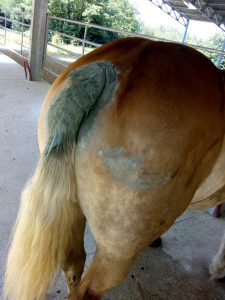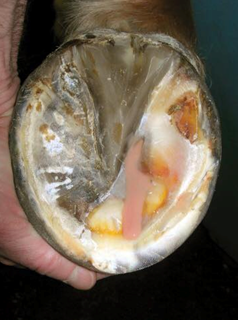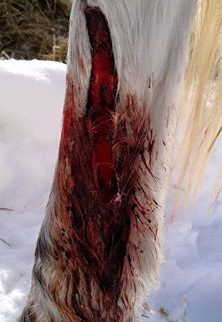Clay for external use
Powdered clay for external use for horses
100%
natural
The quality of a clay
It is recognizable by its grain size (ultra-ventilated like this EXTERNAL CLAY being the best quality). Also its metal content and its quartz content: the more quartz it contains, the less good it is!
There are several colors of clay depending on the location of its deposit: green, white, pink, red, yellow... each has its specific properties, but green is the most widespread because it meets the majority of our needs.
All riders know its benefits when it comes to treating engorgement in their horses' legs, but very few know its other applications, which are numerous.
Clay is a bit like the “Swiss army knife” of the first aid kit: always have it on hand!
But what is clay?
Clay – commonly called "loam" – is composed mainly of silica (at least 50%) and alumina. A powdery material when dry, sticky when wet, it is the result of the thousand-year-old decomposition of sedimentary rocks: it is therefore naturally rich in minerals and trace elements! Depending on their origin, some clays are richer in alumina, others in iron, and still others in magnesium.
Why powdered and not already prepared?
Powdered green clay is more economical: to prepare a kilo of clay paste (poultice in English) you need about 40% water and 60% clay (or even less depending on the desired consistency): why pay for water? In addition, it is only when it comes into contact with water that the clay begins to work, to deploy its beautiful virtues: as long as it is in powder form, it is inert. There is therefore no need to work it very long in advance by buying it and storing it already wet...
Powdered clay does not contain any preservatives, essential oils, cooling agents... it is 100% pure and natural. It can be prepared to the desired consistency and temperature depending on whether you want to cool, warm or relax. You decide the consistency and can add plants or essential oils yourself if you wish and know which ones to use safely (never use metal bowls or utensils, just glass, stoneware, plastic and wood). It does not expire: stored away from humidity it can be kept for years while keeping all its potential intact.
The fresher it is mixed with water, the better its powers and effects will be. However, there's nothing stopping you from making a mixture a little in advance for your competition season, so you always have a small jar on hand or when you have an injury to treat for several days.


- Antibacterial
- Antifungal
- Hemostatic
- Naturally Antiseptic
Strong healing power, soothes and reduces swelling. Safe for your health and that of the horse.
- Can be used during pregnancy, breastfeeding
- Substance not prohibited in competition
- Naturally antiseptic (absorption of germs, bacteria and parasites)
- Its high purity helps relieve congestion in the limbs
- Helps wound healing thanks to its aluminum silicate content
- Soothes and reduces edema
- Prevents mud fever
How to prepare clay
Plasters or poultices
The difference between the two is that for a plaster, the clay is placed directly on the skin (against the grain) while for a poultice, the clay is placed in a cloth (cheesecloth, flannel, cotton). Hold the poultice or plaster in place with a strip of cotton, a wet paper towel, or a cabbage leaf.
For the limbs, apply a support bandage.
The clay works as long as it is moist. Discard the clay after use. Do not add another layer.
Cellophane on clay
This method has the disadvantage of not allowing the skin to breathe and is no longer recommended. Risk of overheating – Possible allergies. Check.
On an injury
Apply the plaster directly to the wound. Once dry, gently remove as much as possible with warm water and reapply a plaster if necessary.
Some examples of treatments given using clay
During an abscess
- Soak the hoof in an Epsom salt bath for about 15 minutes, then you can prepare your clay plaster to the desired consistency with warm water.
- Fill the entire underside of the hoof well
- Make your bandage to hold it all in place.
Repeat twice a day for a maximum of 3 days. If the abscess has not burst, call your veterinarian. An abscess can become a systemic infection and put your horse's life in danger.

During an injury
Clay is a "living bandage" that absorbs the "bad" and allows good cells to regenerate. Its potential benefits are endless! A must-have for hiking and in your first aid kit.
- Wash with saline water
- Apply the clay plaster directly to the wound
If you are unable to wash immediately (when hiking, for example), you can apply the clay powder directly to the wound to stop the bleeding while protecting it.
Want to know more? Have any questions? Don't hesitate to contact us!

Also to discover
Clay for internal use
- Recommended for relieving gastric ulcers
- Regenerates cells (RESET)
- Stimulates the body's defenses
- Adsorbs gas, therefore helps prevent gas colic
Product presentation
- 100% NATURAL
- Certified products
- Simple, efficient, economical
- Benefits known for a very long time
